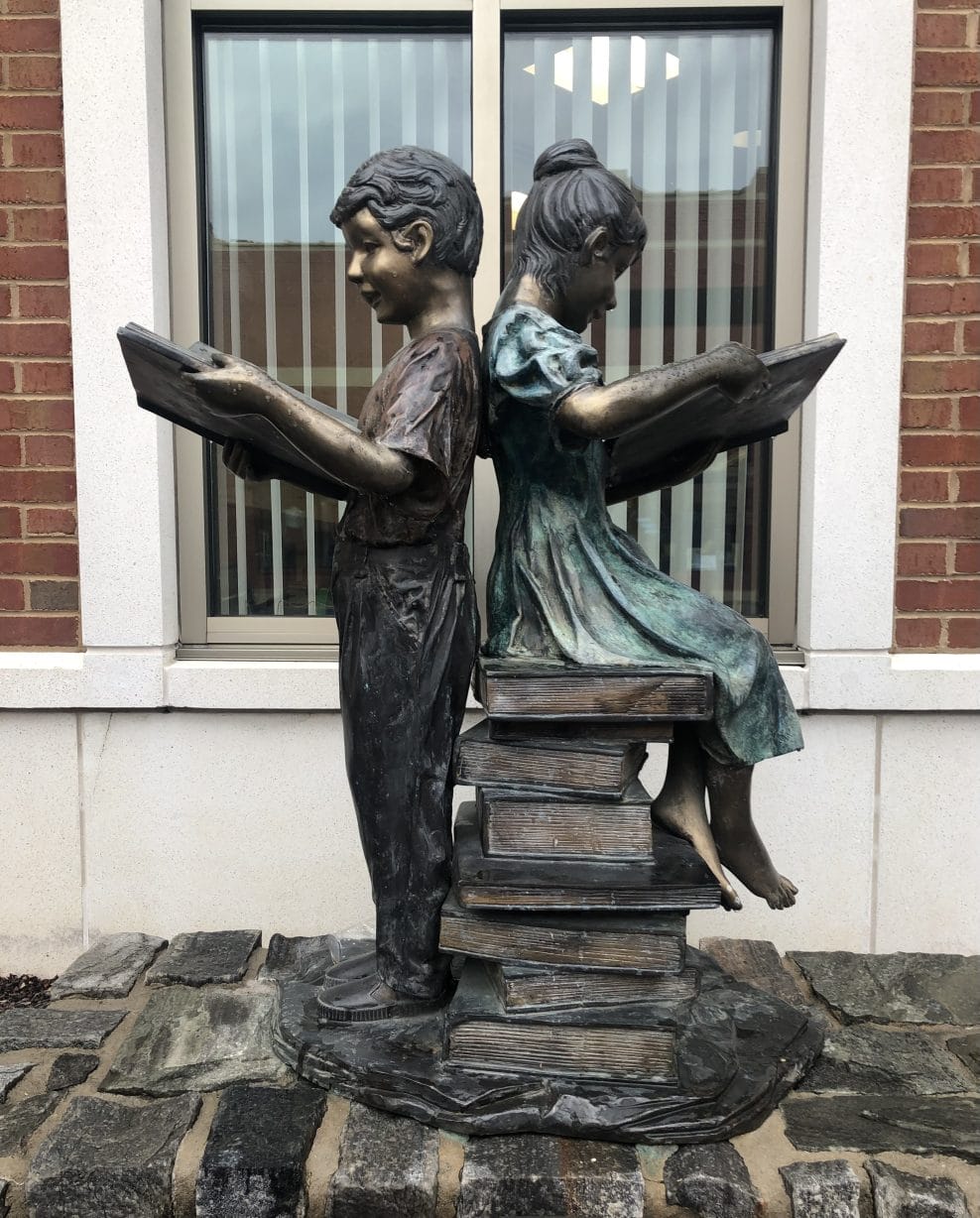
By Sofia Samatar
“The Friendly City” is a weekly column about walking in Harrisonburg that will run during 2024. Each week, your friendly correspondent, writer and teacher Sofia Samatar, will reflect on a walk in our city.
Walk in any direction and you will find them: the frozen children of our town.
A granite boy with a tousled mop of hair. He wears a robe and a cap vaguely suggestive of some religious order. He carries a basin before him in both hands, pitched at an angle as if he’s about to empty it on the grass.
They are standing on the lawns, on the gravel paths, within the shadows of the eaves.
A shepherdess turned to one side, her dress slipping from her shoulder. She has a greenish hue. Rosettes on her skirt, curls twisted on her forehead, a long braid down her back.
A little angel squatting in the weeds. Another praying with clasped hands. A third holding up a lantern.
They are watching in the gardens, in their charmed stillness, their unbreakable poise. Silence flows out of them.
A boy with a glowering, sullen face, tangled stone locks on his brow, bears a basket of dead petals.
A pair seated on a bench. They are perhaps six inches tall. The girl, who looks younger, rests her head on the boy’s shoulder.
They are handsome, chipped, weather-beaten, gleaming in the rain, in every condition from shop-floor brightness to genteel decay. Many are winged, but they never fly. They wait. They adorn the steps and porches, guard the birdbaths, populate the yards.
A black child with white hair clutches a rabbit in both arms.
A child in full color, almost life-size, lounges on a bench. Brown curly hair, a maroon jacket with a broad sailor collar. His dog beside him, he observes the passing cars.
Questions of scale seem not to trouble the children of the sleepy kingdom. The boy with the straw hat stands at his ease beside a blue urn twice his size. The large stone girl, her apron spread wide, is content to share the lawn with a pair of miniscule tots who only come up to her knee.
Is this their role: to beckon us toward a world where everyday concerns dissolve?
Are they more than decorative? Do they have some message to impart? A ragged cherub leans against a rusty railing, holding up both hands. Eternal gesture of supplication.
There is a popular figure I have spotted three times around town: a child in a graceful, dancing posture atop an ornate birdbath. The bath or fountain is made of three tiered basins with scalloped edges. The child is a stone angel, or maybe a human child with a ruffled, windblown cloak. Light and airy it stands, motionless yet making an irresistible impression of movement with its wavy hair, its crossed hands and feet, the drapery of its short dress, and the cloak or wings half furled about it—a spirit belonging equally to water and ice.
I have seen one in pale stone, another in a bronzed, olive color, and then, in a shady garden below the level of the street, a third one completely green with moss, so overgrown with vegetation that its winsome features could hardly be discerned.
I’m reminded of the Lares, the household gods of ancient Rome. These protective spirits were often represented as lively youths. They wore short tunics, flared in winglike folds. Ringlets or wreaths clustered on their brows. They held the sacred vessels, the drinking horn and the offering dish.
A painted angel, her black, flowing tresses crowned with pink roses, her hands cupped. A dark metal girl in the shadow of a fence, head bowed, skirt held out as if to catch a harvest of berries. How often the frozen children seem ready to hold something for us! Their stretched skirts, hollowed palms, basins, and baskets—are they just pretty receptacles for rain and snow? I have read that the Lares shrank over time, fading into folklore, becoming the brownies of nursery tales, who perform household chores if given a bowl of cream. Are they also watching over our yards?
The Lares belonged to individual homes but also to roads, neighborhoods, and cities. These frozen children outside the public library, then, may represent the spirit of this place. Summer and winter they keep their vigil, back to back, the girl perched on a stack of volumes, the boy standing upright. At five o’clock, when the streets begin to empty, these local guardians diffuse an air of green and golden peace. In place of the ritual bowls from which the Romans poured libations long ago, they are holding open books.

